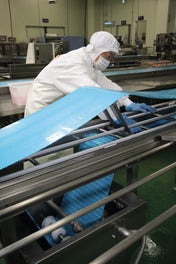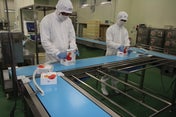Sato Suisan Sushi Enhances Hygiene and Production Efficiency with ThermoDrive Belting

We are very pleased with the ThermoDrive belt. It’s easy to clean, offers lower contamination risk, and the low-tension technology has given the belt a long life with no mistracking issues.
Mr. Akiyoshi Takada
Plant Manager at Sato Suisan Sushi
Customer Objectives
Sato Suisan Sushi Co., Ltd. has produced gourmet bento boxes of premium sushi for the past 40 years. A bento box is a square container for one person that usually includes enough food for a single meal. Popular throughout Japan, bento boxes traditionally include rice, a protein, and vegetables.
The company’s gourmet bento boxes are sold at a pair of airports. Their factory in Chitose, Hokkaido, Japan, operates 24 hours a day to produce approximately 15,000 bento boxes in roughly 50 different food combinations.
Sato Suisan Sushi wanted to improve the hygienic management and production efficiency at their newer factory. Their prior facility used traditional flat belts along processing and packaging lines, but the belts couldn’t be washed with water while on the conveyor. Sanitation required that the belts be removed from the conveyors, a process that demanded four to five workers at a time and occasionally professional engineers.
After cleaning, the flat belts had to stay off the conveyors for an extended period to dry. In addition, the belts were prone to stretching and mistracking, and the potential for belt fray—which could contaminate Sato Suisan Sushi’s product—was a concern for the company.
Intralox Execution
At their newer factory, Sato Suisan Sushi installed hygienically designed conveyors equipped with Intralox ThermoDrive belting and a clean-in-place (CIP) system along processing and packaging lines. ThermoDrive technology is designed for optimal hygiene and cleanability, which makes it ideal for food processing applications. Due to the belt’s unique design, Sato Suisan Sushi was able to enhance layout flexibility—since ThermoDrive belting’s conveyors can be expanded or shortened, and its production lines changed over quickly—to fit production needs. They could also install 12-m-long line conveyors.
Results
Since installing the ThermoDrive belts in November 2011, Sato Suisan Sushi has eliminated the problems they experienced with flat belting. Cleaning the ThermoDrive belts and conveyors requires less time and manual labor, there’s no risk of mistracking or belt fray, and they dry almost instantly.
Sato Suisan Sushi has also improved their production efficiency and flexibility via time savings, enhanced layout flexibility, accurate and predictable production times, and the ability to handle unique processes for each type of bento box—all due to the ThermoDrive solution. The company has experienced no conveyor-related problems since installation and is seeking HACCP and ISO certifications to reflect their hygienic processes.
Mr. Akiyoshi Takada, the plant’s manager, still sees the benefits of the ThermoDrive belting installed in 2011. “It’s easy to clean, offers lower contamination risk, and the low-tension technology has given the belt a long life with no mistracking issues. We can process perfectly according to our production schedule.”

